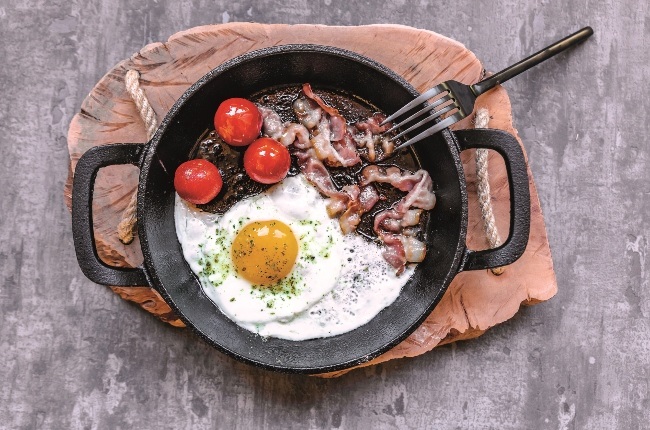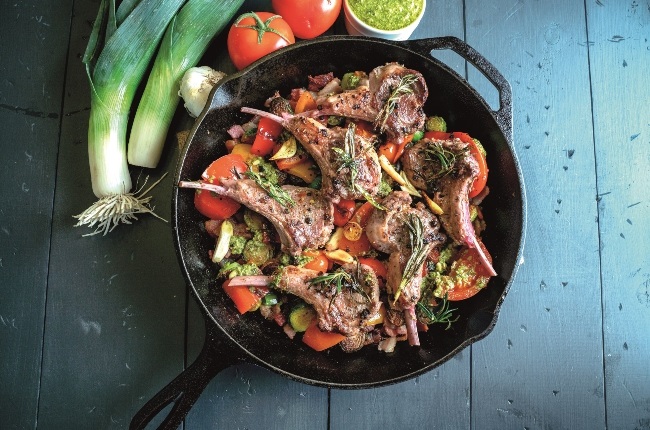
Ask anyone how they feel about carbs and you’re likely to get strong opinions and possibly some strong emotions too.
Some people believe the best thing you can do for your health – and your waistline – is to cut out carbs. Others believe there’s no need to be quite so drastic. Then there are those who’d say the only way you’re going to get that warm, delicious, freshly baked loaf of bread away from them would be to prise it from their cold, dead hands.
There’s no doubt about it – carbs have become controversial.
The low-carb diet trend may have become popular over the past decade or so, but the interest in the link between carbs and weight goes back more than 150 years.
The Banting diet popularised by Professor Tim Noakes in 2012 is named after William Banting, a British undertaker who in the mid-1800s struggled with his weight for years and lost a significant amount by limiting his carb intake.
He tried this dietary change at the suggestion of his physician, Dr William Harvey, who’d learnt about it in the context of diabetes management from attending lectures by a French physiologist about the function of the pancreas. Banting was so astounded by the results of his eating plan that he published a booklet about it called Letter on Corpulence in 1863.
Fast forward to 2021 and we now live in a society where carbs are so readily available and so much a part of our lives that it takes a fair amount of effort to avoid them.
Here’s a look at why cutting carbs will help you lose weight, why it can be so challenging to do, and how you can get started.
Why low carb works for weight loss
Bread, potatoes, pasta, rice, pastries, cakes, biscuits, sweets, chocolate bars.
It’s easy to see why cutting carbs will help you lose weight. But what’s the science behind it?
Carbohydrates are one of the three macronutrients we get from food. The other two are protein and fat.
Carbs are fuel – once consumed, they’re broken down into glucose and the rise in your blood glucose triggers the release of the hormone insulin from your pancreas.
Insulin’s job is to move glucose into your cells to be used as fuel, and if there’s more glucose than can be used right away, this excess is stored in the liver in the form of glycogen for later use, or as fat.
If your diet is high in carbs, it means there’s regularly far more glucose in your blood than your body can use – and so it gets stored. It also means your pancreas is constantly pumping out insulin and the cells that produce it can start burning out.
If you look at a typical Western diet today, it’s easy to see how carb intake can get out of control.
“One cup of rice is the equivalent of 10 teaspoons of sugar,” says Dr Stefanus Snyman, a Cape Town-based health educator and medical doctor at Fire Diabetes, an organisation dedicated to helping reverse type 2 diabetes and in-?sulin resistance.
“A potato has about nine teaspoons of sugar. A glass of apple juice has more than eight teaspoons of sugar.“
We produce a lot of insulin to deal with all that sugar – and constant high levels of insulin leads to insulin resistance.”
The aim of a low-carb diet is to manage your blood sugar and as a result the amount of insulin your body produces.
But don’t we need carbs for energy?
Carbs are a source of fuel, but they’re not our only source of energy.
“Carbs are actually not essential in the human diet,” Snyman says.
The body can also burn fat for fuel – and this is essentially what happens on low-carb diets such as Banting and keto, which both take a low-carb, high-fat and moderate-protein approach.
“On a low-carb diet your body uses fat and not glucose for energy,” Snyman says. “When you eat fat it’s converted into fatty acids, and these can go directy into the body’s cells to be burnt for energy.
“You actually can’t live without fat – it’s a necessary building block in our cells – and it also works as fuel.”
When you starve your body of carbs it goes into a state known as ketosis, Snyman says, where you burn fat for energy. This is why low-carb diets work so well for weight loss – you start burning your fat stores.
“Fat actually burns for much longer than glucose. That’s why you don’t get as hungry on a low-carb diet and don’t have to eat every three to four hours,” he says.
“You don’t get hungry because you don’t have blood sugar and insulin spikes,” says Amanda Kotzé, a Johannesburg-based dietitian at Metabolica Med Dietitians. “You also have fewer cravings because the source of cravings is also blood sugar that goes up and down.”
Not all carbs are equal
You’ve probably heard them referred to as good and bad carbs. On the one side you have apples, beetroot and oats, for example. On the other you have biscuits, cake, sweetened cooldrinks and potato chips.
They’re all essentially carbohydrates, but in terms of nutrition they’re worlds apart. Although vegetables and fruit contain carbs, they come with nutrients and fibre and can be part of a nutritionally balanced diet if they are consumed in their natural (unprocessed) state.
It’s the highly processed, refined carbs that are the problem as these have little to no nutritional value, says Claudine Ryan, a registered dietician with practices in Gqeberha and Durbanville, Cape Town.
The most important change you can make for your health is to cut all added sugar and refined carbs.
If your diet is high in refined carbs you’ll feel a difference if you simply cut all added sugar and refined carbs. If you have a medical condition or are on chronic medication consult a doctor who’s informed about low-carb diets before you start.
BAD CARBS – AVOID THESE COMPLETELY
- Highly processed
- Also called simple carbs
- Often contain added sugar
- Low in fibre
- Quickly digested, leading to blood-sugar spikes
- Little or no nutrients
Examples: Bread made with refined flour, baked goods made with refined flour, such as pastries, cake, biscuits, doughnuts and rusks, cereals, fruit juice, sweetened cooldrinks, potato chips, chocolate bars and sweets
GOOD CARBS – BUT YOU STILL NEED TO KEEP INTAKE LOW
- Unprocessed (or minimally processed)
- Also called complex carbs
- High in fibre
- More slowly digested
- Also contain nutrients and antioxidants
Examples: wholegrains such as oats and brown rice, starchy (but not white) veggies such as carrots, sweet potato, beetroot and beans
How low should you go?
There’s no simple answer to this question because it’s all about you. You need to become more aware of and understand how carbs affect your body. You need to figure out the minimum amount you can stick to long term – that’s if you even want to count your daily carbs in terms of grams.
Theoretically you don’t have to count carbs if you limit them overall, Kotzé says.
“If you exclude all high-carb foods, starchy vegetables, most fruits and don’t have too much dairy, then you won’t be taking in too many carbs.
“There are different levels of carb restriction depending on your health markers, weight, height and age. A truly low-carb diet would be 20-50g of carbs a day or 5-10% of total daily kilojoule intake,” she adds.
“As it’s difficult for people to change to a low-carb diet, we as low-carb dieticians work out a meal plan according to each person’s situation and health to start them off, and then support and guide them to come off the meal plan and make it a lifestyle.”
It’s important to develop a good relationship with your body, Kotzé adds. Once you’ve become accustomed to a lower carb intake, you’ll become more aware of how eating carbs makes your body feel.
It’s enough to keep your carb intake below 130g a day, or 26% of total daily kilojoule intake, Ryan believes.
The fewer carbs you eat, the more effective it appears to be for weight loss without hunger, according to low-carb website dietdoctor.com. It regards 50-100g of carbs a day as liberal, 20-50g as moderate and below 20g as ketogenic.
You can choose low-carb as a broad, general approach to eating, or you can get quite technical about it (particularly if you want to lose weight) and calculate exactly how many grams of carbs, protein and fat you should eat every day.
If you want to go the latter route it’s best to consult a dietician who specialises in the low-carb lifestyle or a doctor who is informed about low-carb and how it can be used to reverse insulin resistance.
Carbs are not just fuel
Nutritionally speaking, carbs are a source of energy. But unfortunately it’s not quite as simple as that. Carbs aren’t just fuel. Carbs are also comfort.
The smell of freshly baked bread just out of the oven. The deliciousness of pasta smothered in a creamy sauce. The sweet delight of chocolate cake. Even that cold beer you enjoy now and then – yes, that’s on the carb list too.
All of this can make giving up carbs pretty difficult. Not impossible, but certainly not easy. And it points to something that needs to be addressed if you want to lose weight – that we eat for many reasons, not just for physical hunger.
If you’re an emotional eater – and let’s face it, aren’t we all now and then – you’ll need to figure out how to deal with it.
Another obstacle is that carbs are convenient. They’re everywhere, they’re ready-to-eat and they tend to be cheap.
An important part of making the switch to a low-carb diet is to find good resources, arm yourself with knowledge and plan your meals.
How does keto fit in?
The ketogenic diet is an extremely low-carb, high-fat diet that was found to reduce seizures in children with epilepsy.
The very low carb intake – usually less than 20g a day – puts the body into a metabolic state called ketosis, where it burns fat for fuel. Epileptic seizures are triggered by abnormal electrical discharges in the brain and research suggests ketosis disrupts these abnormal discharges.
“You’re forcing the brain to use a different fuel. We don’t know exactly how it works,” says Dr Judith Bluvstein, a paediatric epileptologist and assistant professor of neurology at New York University. “But it’s almost as though the brain can’t figure out how to produce seizures using this new energy pathway.”
The ketogenic diet has also been found to have other health benefits, including reversing insulin resistance and type 2 diabetes, protecting brain function, reducing the risk of certain kinds of cancers, and improving the symptoms of polycystic ovary syndrome (PCOS).
Because the keto diet makes your body incredibly efficient at burning fat for energy, it also works well for weight loss. But the extremely low carb intake is restrictive and makes it challenging to sustain long-term.
What’s keto ‘flu’?
This is basically what happens when your body is in carb withdrawal as you transition from burning carbs for fuel to burning fat for fuel (ketosis). Keto flu can last anywhere from three days to a week and symptoms include fatigue, brain fog, constipation, fruity breath, dizziness and diarrhoea.
- Cook all your meals from scratch. This helps you keep the focus on meat, fish, poultry, eggs and vegetables and steer clear of processed foods.
- Be careful with fruit. Yes, it’s fresh but fruit also contains a lot of sugar. “Choose blueberries, strawberries, raspberries and blackberries,” saysdietician Amanda Kotzé. A good rule of thumb is to limit yourself to one fist-size fruit a day.
- The general rule with low-carb diets is that you should only eat when hungry and although snacking is allowed, it’s not encouraged. If you do cheat, don’t beat yourself up. “Just make sure the next meal you have is low-carb,” Kotzé says.
- Meal prep is important. “This lifestyle requires you to cook fresh food, so plan what you’re going to eat for the week,” Kotzé adds. If you’re going to a braai or family function, take a lowcarb dish along.
- Learn how to read food labels – it’s important to become more aware of what’s in the products you buy.
- Check the ingredients list for sugar as well as total carbohydrates.
For more low carb inspired recipes check out YOU best diets
EXTRA SOURCES: HEALTH24.COM, WEBMD.COM, MEDLINEPLUS.GOV, DIABETES.CO.UK, REALMEALREVOLUTION.COM, NCBI.NLM.NIH.GOV, MAYOCLINIC.ORG, HEALTHLINE.COM, FIREDIABETES.COM, ENDOCRINEWEB.COM, THEGUARDIAN.COM, DIETDOCTOR.COM




 Publications
Publications
 Partners
Partners



















